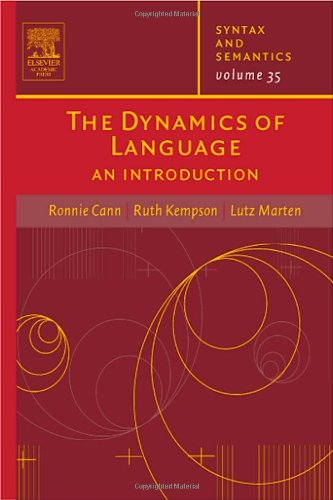
Synopsis
Argues that knowledge in language consists of being able to use it in speaking and understanding. This work analyses a variety of languages, from English to Japanese and Swahili. It is intended for those in the disciplines of language, linguistics, anthropology, education, psychology, cognitive science, law, media studies, and medicine.
"synopsis" may belong to another edition of this title.
Review
"This book represents an uncommon achievement in successfully using detailed analyses of typologically diverse languages to address foundational questions about what it means to know a language and about the relation between speaking and understanding. This book will be of interest to anybody who is serious about the cognitive science of syntax and semantics."
--Colin Phillips, University of Maryland, USA
"For anyone interested in the basic nature of natural language syntax, this book is a necessary, and enjoyable, read. The authors provide a new take on how interpretations are constructed by language users,and back up their general theoretical proposals with original analyses of an eclectic range of linguistic phenomena. The exposition
is clear and engaging–and challenging. You will have some of your assumptions shaken up; whether they fall back in place, or are radically rearranged, the experience is stimulating."
--Caroline Heycock, University of Edinburgh, UK
Synopsis
For the whole of the last half-century, most theoretical syntacticians have assumed that knowledge of language is different from the tasks of speaking and understanding. There have been some dissenters, but, by and large, this view still holds sway. This book takes a different view: it continues the task set in hand by Kempson et al (2001) of arguing that the common-sense intuition is correct that knowledge of language consists in being able to use it in speaking and understanding."The Dynamics of Language" argues that interpretation is built up across as sequence of words relative to some context and that this is all that is needed to explain the structural properties of language. The dynamics of how interpretation is built up is the syntax of a language system. The authors' first task is to convey to a general linguistic audience with a minimum of formal apparatus, the substance of that formal system. Secondly, as linguists, they set themselves the task of applying the formal system to as broad an array of linguistic puzzles as possible, the languages analysed ranging from English to Japanese and Swahili.'
This book makes an uncommon achievement in successfully using detailed analyses of typologically diverse languages to address foundational questions about what it means to know a language and about the relation between speaking and understanding. This book will be of interest to anybody who is serious about the cognitive science of syntax and semantics' - Colin Phillips, University of Maryland, USA. 'For anyone interested in the basic nature of natural language syntax, this book is a necessary, and enjoyable, read. The authors provide a new take on how interpretations are constructed by language users,and back up their general theoretical proposals with original analyses of an eclectic range of linguistic phenomena. The exposition is clear and engaging-and challenging. You will have some of your assumptions shaken up; whether they fall back in place, or are radically rearranged, the experience is stimulating' - Caroline Heycock, University of Edinburgh, UK."About this title" may belong to another edition of this title.
Other Popular Editions of the Same Title
Search results for The Dynamics of Language: An Introduction: 35 (Syntax...
The Dynamics of Language: An Introduction (Volume 35)
Seller: Anybook.com, Lincoln, United Kingdom
Condition: Good. Volume 35. This is an ex-library book and may have the usual library/used-book markings inside.This book has hardback covers. In good all round condition. Please note the Image in this listing is a stock photo and may not match the covers of the actual item,900grams, ISBN:9780126135350. Seller Inventory # 9742797
Buy Used
Ships from United Kingdom to U.S.A.
Quantity: 1 available
The Dynamics Of Language: An Introduction
Seller: Jonathan Grobe Books, Deep River, IA, U.S.A.
Hardcover. Condition: Very Good. Dust Jacket Condition: No Dust Jacket. Exlibrary with usual library markings. ; 440 pages. Seller Inventory # 46798
The Dynamics of Language
Seller: THE SAINT BOOKSTORE, Southport, United Kingdom
Hardback. Condition: New. This item is printed on demand. New copy - Usually dispatched within 5-9 working days 874. Seller Inventory # C9780126135350
Buy New
Ships from United Kingdom to U.S.A.
Quantity: Over 20 available
DYNAMICS OF LANGUAGE
Seller: moluna, Greven, Germany
Gebunden. Condition: New. Argues that knowledge in language consists of being able to use it in speaking and understanding. This work analyses a variety of languages, from English to Japanese and Swahili. It is intended for those in the disciplines of language, linguistics, anthropo. Seller Inventory # 594359770
Buy New
Ships from Germany to U.S.A.
Quantity: Over 20 available
The Dynamics of Language: An Introduction (SYNTAX AND SEMANTICS, 35)
Seller: Mispah books, Redhill, SURRE, United Kingdom
hardcover. Condition: Good. Good. Dust Jacket NOT present. CD WILL BE MISSING. . SHIPS FROM MULTIPLE LOCATIONS. book. Seller Inventory # ERICA82901261353553
Buy Used
Ships from United Kingdom to U.S.A.
Quantity: 1 available
The Dynamics of Language
Seller: AHA-BUCH GmbH, Einbeck, Germany
Buch. Condition: Neu. Neuware - For the whole of the last half-century, most theoretical syntacticians have assumed that knowledge of language is different from the tasks of speaking and understanding. There have been some dissenters, but, by and large, this view still holds sway. Seller Inventory # 9780126135350

